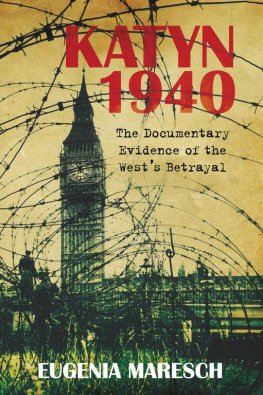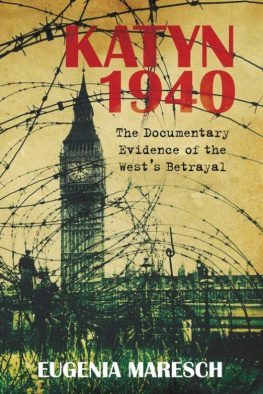Charles River Editors - The Katyn Forest Massacre: The History of the Notorious Slaughter of Polish Prisoners by the Soviets during World War II
Here you can read online Charles River Editors - The Katyn Forest Massacre: The History of the Notorious Slaughter of Polish Prisoners by the Soviets during World War II full text of the book (entire story) in english for free. Download pdf and epub, get meaning, cover and reviews about this ebook. year: 2016, publisher: Charles River Editors, genre: Science. Description of the work, (preface) as well as reviews are available. Best literature library LitArk.com created for fans of good reading and offers a wide selection of genres:
Romance novel
Science fiction
Adventure
Detective
Science
History
Home and family
Prose
Art
Politics
Computer
Non-fiction
Religion
Business
Children
Humor
Choose a favorite category and find really read worthwhile books. Enjoy immersion in the world of imagination, feel the emotions of the characters or learn something new for yourself, make an fascinating discovery.
- Book:The Katyn Forest Massacre: The History of the Notorious Slaughter of Polish Prisoners by the Soviets during World War II
- Author:
- Publisher:Charles River Editors
- Genre:
- Year:2016
- Rating:3 / 5
- Favourites:Add to favourites
- Your mark:
- 60
- 1
- 2
- 3
- 4
- 5
The Katyn Forest Massacre: The History of the Notorious Slaughter of Polish Prisoners by the Soviets during World War II: summary, description and annotation
We offer to read an annotation, description, summary or preface (depends on what the author of the book "The Katyn Forest Massacre: The History of the Notorious Slaughter of Polish Prisoners by the Soviets during World War II" wrote himself). If you haven't found the necessary information about the book — write in the comments, we will try to find it.
The Katyn Forest Massacre: The History of the Notorious Slaughter of Polish Prisoners by the Soviets during World War II — read online for free the complete book (whole text) full work
Below is the text of the book, divided by pages. System saving the place of the last page read, allows you to conveniently read the book "The Katyn Forest Massacre: The History of the Notorious Slaughter of Polish Prisoners by the Soviets during World War II" online for free, without having to search again every time where you left off. Put a bookmark, and you can go to the page where you finished reading at any time.
Font size:
Interval:
Bookmark:
By Charles River Editors

A picture of Polish POWs captured by the Soviets

Charles River Editors is a boutique digital publishing company, specializing in bringing history back to life with educational and engaging books on a wide range of topics. Keep up to date with our new and free offerings with this 5 second sign up on our weekly mailing list , and visit Our Kindle Author Page to see other recently published Kindle titles.
We make these books for you and always want to know our readers opinions, so we encourage you to leave reviews and look forward to publishing new and exciting titles each week.

A picture of a memorial commemorating the massacre in Poland
The Katyn Forest Massacre
It has been suggested that the motive for this terrible step was to reassure the Germans as to the reality of Soviet anti-Polish policy. This explanation is completely unconvincing in view of the care with which the Soviet regime kept the massacre secret from the very German government it was supposed to impressA more likely explanation is that [the massacre] should be seen as looking forward to a future in which there might again be a Poland on the Soviet Union's western border. Since he intended to keep the eastern portion of the country in any case, Stalin could be certain that any revived Poland would be unfriendly. Under those circumstances, depriving it of a large proportion of its military and technical elite would make it weaker. Gerhard Weinberg
During the late 1930s the Soviet Union under Josef Stalin and the Third Reich under Adolf Hitler reached a secret alliance, the Molotov-Ribbentrop Pact. By the terms of this agreement, the two dictators divided up Eastern Europe between them, and for a time Stalin even sought Axis membership.
Though the alliance forged between the fascist and communist states could not survive their diametrically opposed views, they cooperated long enough to conquer Poland together in 1939. Of course, as most people now know, the invasion of Poland was merely the preface to the Nazi blitzkrieg of most of Western Europe, which would include Denmark, Belgium, and France by the summer of 1940. The resistance put up by these countries is often portrayed as weak, and the narrative is that the British stood alone in 1940 against the Nazi onslaught, defending the British Isles during the Battle of Britain and preventing a potential German invasion.
In particular, the campaign in Poland is remembered as one in which an antiquated Polish army was quickly pummeled by the worlds most modern army. Polish lancers charging in a valiant yet idiotic attack against German tanks is the only image from the 1939 Nazi-Soviet invasion of Poland remaining in the popular imagination today. Originating as a piece of Nazi propaganda, paradoxically adopted by the Poles as a patriotic myth, the fictional charge obscures the actual events of September 1939. Outnumbered, outgunned, and under-equipped, the Polish army nevertheless inflicted heavy losses on the invading Wehrmacht. In fact, only the unexpected advance of Soviet forces from the east put a quick end to the struggle and saw the Polish republic partitioned again after just 20 years of independence. Nonetheless, the campaign that started World War II was a bloody sign of things to come as the conflict engulfed the globe.
While the Germans performed the lions share of military action in defeating Poland and reaped the choicest regions for themselves as a consequence the Soviets showed themselves no laggards in establishing tyrannical control over the Polish zone assigned to them by treaty. NKVD death squads, mass deportations, and systematic repression began almost immediately in the Soviet-controlled part of Poland.
The Gestapo applied their own forms of brutality in the German zone of the conquered nation, but the results proved starkly different. A large-scale, well-organized Polish Resistance movement flourished in the German zone, exhibiting high morale and an activist approach that testified to the relatively amateurish nature of the Gestapo repression random violence for intimidation rather than systematic quashing of all independence and defiance.
The NKVD, on the other hand, managed to virtually eliminate any large-scale resistance in the Russian zone. The Soviet policy proved a dark success, at least until the Wehrmacht surged crushingly across the border into the Soviet Union during the Operation Barbarossa offensive of June 1941. A key element of this policy lay in the elimination of tens of thousands of leading Poles in what became known as the Katyn Massacre or the Katyn Forest Massacre.
The massacre, a series of mass executions that murdered over 20,000 Poles, was one of the most controversial events of the war. The Soviets blamed the Nazis for the slaughter for decades, only admitting its responsibility in 1990 as the USSR was on the verge of dissolution, and even then they refused to officially find any Soviet individuals liable or responsible.
The Katyn Forest Massacre: The History of the Notorious Slaughter of Polish Prisoners by the Soviets during World War II chronicles one of the most notorious massacres of the war. Along with pictures of important people and places, you will learn about the Katyn Forest Massacre like never before.
Forged from the wreck of empires following World War I, Poland represented both a practical and a symbolic stumbling block to the ambitions of both Nazi and Soviet leaders by the late 1930s. Prussia, Austria, and Russia had extinguished Polish sovereignty on October 24 th , 1795 with the "Third Partition," absorbing the Polish Commonwealth into their respective empires, and a secret treaty clause pledged all three powers to work to permanently "abolish" the existence of Poland. With that, the imperial partners drove many leading Poles into exile, but nevertheless, Polish patriotism survived, flourishing underground and emerging periodically. The Polish aided Napoleon Bonaparte with superb lancer cavalry, relishing the chance to strike back at the loathed Russians, Prussians, and Austrians, but while the Poles also hoped for restoration of their Republic, this did not occur until over 100 years after the Napoleonic Era.
The fall of the German and Russian empires in 1917 and 1918 presented Poland with its opportunity. Led by Jozef Pisudski, the Poles founded a democratic nation in 1918 with the blessing of the Western Allies. However, the emergent, blood-soaked dictatorship of the Soviet Union took a far different view of Poland's resurrection: [I]n spring 1920, Lenin and Trotsky thought that they would bring their own revolution to Poland, using the bayonet to inspire workers to fulfill their historical role. After Polands fall, German comrades, assisted by the new Red Army, would bring to bear Germanys vast resources to save the Russian revolution. But the Soviet forces on their way to Berlin were halted by the Polish Army at Warsaw in August 1920. (Snyder, 2010, 24).

Font size:
Interval:
Bookmark:
Similar books «The Katyn Forest Massacre: The History of the Notorious Slaughter of Polish Prisoners by the Soviets during World War II»
Look at similar books to The Katyn Forest Massacre: The History of the Notorious Slaughter of Polish Prisoners by the Soviets during World War II. We have selected literature similar in name and meaning in the hope of providing readers with more options to find new, interesting, not yet read works.
Discussion, reviews of the book The Katyn Forest Massacre: The History of the Notorious Slaughter of Polish Prisoners by the Soviets during World War II and just readers' own opinions. Leave your comments, write what you think about the work, its meaning or the main characters. Specify what exactly you liked and what you didn't like, and why you think so.



















